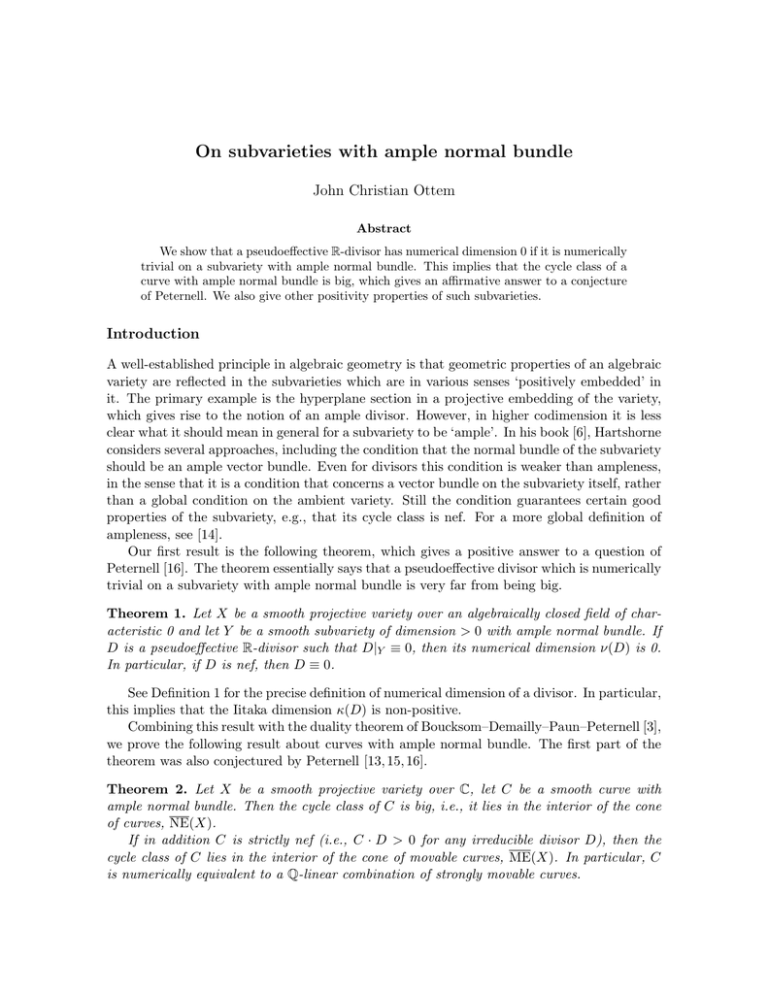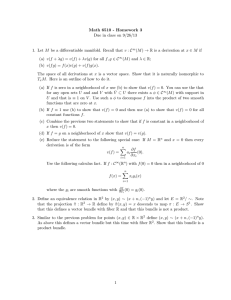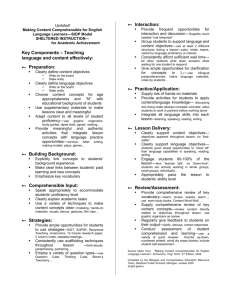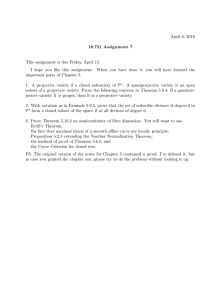On subvarieties with ample normal bundle John Christian Ottem
advertisement

On subvarieties with ample normal bundle
John Christian Ottem
Abstract
We show that a pseudoeffective R-divisor has numerical dimension 0 if it is numerically
trivial on a subvariety with ample normal bundle. This implies that the cycle class of a
curve with ample normal bundle is big, which gives an affirmative answer to a conjecture
of Peternell. We also give other positivity properties of such subvarieties.
Introduction
A well-established principle in algebraic geometry is that geometric properties of an algebraic
variety are reflected in the subvarieties which are in various senses ‘positively embedded’ in
it. The primary example is the hyperplane section in a projective embedding of the variety,
which gives rise to the notion of an ample divisor. However, in higher codimension it is less
clear what it should mean in general for a subvariety to be ‘ample’. In his book [6], Hartshorne
considers several approaches, including the condition that the normal bundle of the subvariety
should be an ample vector bundle. Even for divisors this condition is weaker than ampleness,
in the sense that it is a condition that concerns a vector bundle on the subvariety itself, rather
than a global condition on the ambient variety. Still the condition guarantees certain good
properties of the subvariety, e.g., that its cycle class is nef. For a more global definition of
ampleness, see [14].
Our first result is the following theorem, which gives a positive answer to a question of
Peternell [16]. The theorem essentially says that a pseudoeffective divisor which is numerically
trivial on a subvariety with ample normal bundle is very far from being big.
Theorem 1. Let X be a smooth projective variety over an algebraically closed field of characteristic 0 and let Y be a smooth subvariety of dimension > 0 with ample normal bundle. If
D is a pseudoeffective R-divisor such that D|Y ≡ 0, then its numerical dimension ν(D) is 0.
In particular, if D is nef, then D ≡ 0.
See Definition 1 for the precise definition of numerical dimension of a divisor. In particular,
this implies that the Iitaka dimension κ(D) is non-positive.
Combining this result with the duality theorem of Boucksom–Demailly–Paun–Peternell [3],
we prove the following result about curves with ample normal bundle. The first part of the
theorem was also conjectured by Peternell [13, 15, 16].
Theorem 2. Let X be a smooth projective variety over C, let C be a smooth curve with
ample normal bundle. Then the cycle class of C is big, i.e., it lies in the interior of the cone
of curves, NE(X).
If in addition C is strictly nef (i.e., C · D > 0 for any irreducible divisor D), then the
cycle class of C lies in the interior of the cone of movable curves, ME(X). In particular, C
is numerically equivalent to a Q-linear combination of strongly movable curves.
Interestingly, Voisin [19] showed that the corresponding result is false for subvarieties of
higher dimensions. More precisely, she gives examples of smooth projective varieties in any
dimension ≥ 4, containing a codimension 2 subvariety with ample normal bundle, but whose
class is in the boundary of the pseudoeffective cone. In these examples, the subvariety deforms
in a family covering the ambient variety and the normal bundle is even globally generated.
The strictly nef assumption in the second part of the theorem is necessary. Indeed, take
any smooth projective variety with a curve with ample normal bundle and blow up a point
outside it. Then on the blow-up, the preimage of the curve, C, has ample normal bundle, but
the exceptional divisor satisfies E · C = 0, so C lies in the boundary of the cone of movable
curves.
On the other hand, the following theorem says that there can be at most finitely many
prime divisors disjoint from C.
Theorem 3. Let X be a smooth projective variety over C and let Y ⊂ X be a smooth
subvariety of dimension at least one with ample normal bundle. Then Y intersects all but
finitely many prime divisors on X. In fact, the number of such divisors is less than the
Picard number of X.
All of the above results remain valid if Y is assumed to be locally complete intersection
instead of smooth.
Thanks to Frédéric Campana and Burt Totaro for comments and useful discussions.
1 Curves with positivity properties
P
Let X be a smooth projective variety. An R-divisor is a finite sum D =
λi Di where λi ∈ R
and each Di is an irreducible divisor in X. Write N 1 (X) = Pic(X)⊗R/ ≡ for the Néron-Severi
group of X, i.e., the R-vector space of divisors modulo numerical equivalence. In N 1 (X) we
define the effective cone Eff(X) as the cone spanned by effective divisors and the nef cone
Nef(X) as the cone of nef divisors, i.e., R-divisors such that D · C ≥ 0 for every curve C on
X. An R-divisor is pseudoeffective if its class lies in the closure Eff(X) of the effective cone.
We let N1 (X) denote the vector space of 1-cycles modulo numerical equivalence, and
NE(X) the cone spanned by curves on X. We call a cycle α ∈ N1 (X) big if it lies in the
interior of NE(X). Inside NE(X), there is the subcone ME(X) spanned by curves that are
movable. Here a curve C is called movable if it is a member of a family of curves that
dominates X. By definition, the cones Nef(X) and NE(X) are dual with respect to the
intersection pairing. A fundamental result of Boucksom–Demailly–Paun–Peternell [3], states
that for a smooth variety over C, also the cones ME(X) and Eff(X) are dual, i.e., a divisor D
is pseudoeffective if and only if D · C ≥ 0 for all movable curves C. Moreover, they show that
ME(X) coincides with the closure of the cone spanned by curves which are strongly movable,
that is, 1-cycles of the form f∗ (H1 ∩ · · · ∩ Hn−1 ), where the Hi are very ample divisors on X 0
and f : X 0 → X is birational.
1.1 Subvarieties with ample normal bundle
Recall that a vector bundle E on a variety is ample if the line bundle O(1) is ample on P(E ).
Here and throughout the paper we use the Grothendieck notation for projectivized bundles,
i.e., P(E ) is the variety of hyperplanes in E . If E is a vector bundle on a curve, E is ample if
and only if every quotient line bundle of E has positive degree [7]. We will mainly consider
the case when E is the normal bundle NY = (I/I 2 )∗ , of a subvariety Y ⊂ X, which is a
2
vector bundle of rank equal to the codimension when Y is smooth (or more generally locally
complete intersection.)
Subvarieties with ample normal bundle share many interesting geometric properties with
ample divisors (see e.g., [6] or [9]). For example, for every coherent sheaf F , the cohomology
groups H i (X −Y, F ) are finite-dimensional vector spaces for i < dim Y [6]. Also, if dim Y ≥ 1,
a result of Napier and Ramachandran [12] says im(π1 (Y ) → π1 (X)) has finite index in π1 (X).
A property which will be important for our purposes is the following:
Proposition 4. [9, Corollary 8.4.3] Let Y ⊂ X be a subvariety with ample normal bundle,
then Y is nef, i.e., Y · Z ≥ 0 for any subvariety with dim Y + dim Z = dim X.
In his book [6], Hartshorne presented two of his influential conjectures about such subvarieties:
Conjecture A (Hartshorne). Let Y ⊂ X be a smooth subvariety of X such that the normal
bundle NY is an ample vector bundle. Is it true that some multiple of Y deforms (as a cycle)
in a family covering X?
Conjecture B (Hartshorne). Let Y, Z be smooth subvarieties of X with such that the normal
bundles NY , NZ are ample vector bundles. If dim Y + dim Z ≥ dim X, then Y ∩ Z 6= ∅.
It is known by results of [5] that Conjecture A implies Conjecture B. Unfortunately,
Fulton and Lazarsfeld also showed that Conjecture A is false in general when dim Y ≥ 2.
Their counterexample is based on constructing a certain ample rank two vector bundle on
Y = P2 , so that no multiple of the zero-section moves in the total space of the bundle.
Given this, one asks whether it is still true that a curve C with ample normal bundle
has a multiple that moves in X. This question is open in general, but is known when X is a
surface or when g(C) ≤ 1. Further evidence for this is given by the result of Campana and
Flenner [4], which states that some multiple of the zero-section moves in the normal bundle.
In particular, this implies that the example of Fulton and Lazarsfeld cannot be modified to
the dimension 1 case.
Theorem 2 can be viewed as a weak form of Hartshorne’s Conjecture A. Indeed, since the
cycle class of C ⊂ X is big, a multiple of it can be written as h + e where h is the class of
a complete intersection of n − 1 sufficiently ample divisors and e is an effective 1-cycle. In
particular, for any finite set of points in X, there is an effective cycle numerically equivalent to
mC which passes through them. Note also that if C is in addition assumed to be strictly nef,
Theorem 2 implies that some integral multiple of C is even equivalent to a sum of strongly
movable curves in X.
1.2 Examples
(i) If D is a divisor with ample normal bundle, then D is nef and big [19]. In particular, when
X is a surface, Theorems 1 and 3 follow directly from the Hodge index theorem.
(ii) If Y is a complete intersection, or more generally, a transverse intersection of subvarieties with ample normal bundle, then NY is ample.
(iii) Any smooth subvariety of projective space has ample normal bundle, since it is the
quotient of the tangent bundle TPn which is ample [9].
(iv) If the normal bundle NC is sufficiently ample in the sense that h0 (NC ) ≥ dim X − 1
and h1 (NC ) = 0, then the curve C itself moves in a family covering X. In this case it is known
that C is big by [16, Theorem 4.11]. In particular, this holds when C is rational or elliptic.
3
In fact, a variety is rationally connected if and only if it contains a rational curve with ample
normal bundle. In [13], Oguiso and Peternell give an analogous geometric characterization
when C is an elliptic curve in a threefold.
(v) If C has genus g ≥ 2, the subvarieties Wd (C) ⊂ Jac(C) have ample normal bundles.
In this example, it is classically known that the cycle-class of C is in the interior of the cone
1
of curves of Jac(C). In fact, Poincaré’s formula gives that C ≡ (g−1)!
Θg−1 , where Θ is the
theta divisor of Jac(C), which is ample.
(vi) If X is a homogenous manifold, then the ampleness of the normal bundle of a subvariety can often be interpreted geometrically. For example, Y is non-degenerate. If X is an
abelian variety and C is a curve, then NC is ample if and only if a translate of C generates
X as a group [9]. If X is a quadric, then by [1, Theorem 1], the normal bundle NC is ample
if and only if C is not a line. In general, a line in a homogeneous manifold has ample normal
bundle if and only if X = Pn .
(vii) Bigness of the cycle class of C has however no implications for the positivity of the
normal bundle. Indeed, take any 3-fold with Picard number one containing a (−1, −1) curve:
then NC = O(−1) ⊕ O(−1), and C is big because NE(X) is 1-dimensional.
2 Proof of Theorem 1 and 2
2.1 Divisorial Zariski decomposition
We briefly recall the divisorial Zariski decomposition introduced by Boucksom [2] and Nakayama
[11]. Let X be a smooth projective variety and let D be a pseudoeffective R-divisor. We define
the diminished base locus of D by
[
B− (D) =
BR (D + A),
A
T
where A runs over all ample divisors and BR (D) = {Supp(D0 )|D0 ≥ 0 and D0 ∼R D}. It is
known that B− (D) is a countable union of closed subsets [11]. Let H be an ample line bundle
on X. For each prime divisor Γ on X define the coefficient
σΓ (D) = lim inf{multΓ (D0 )|D0 ∼R D + H and D0 ≥ 0}
→0+
It was shown by Nakayama [11, III.1.5] that these numbers do not depend on the choice of H
and that there are only finitely
many prime divisors Γ such that σΓ (D) > 0. Following [11]
P
we then define Nσ (D) = Γ σΓ (D)Γ and Pσ (D) = D − Nσ (D), and call D = Nσ (D) + Pσ (D)
the divisorial Zariski decomposition of D.
The main properties of this decomposition are captured by the following
Proposition 5. [11, III.1.14, III.1.17] Let D be a pseudoeffective R-divisor.
(i) Nσ (D) is effective and Supp(Nσ (D)) coincides with the divisorial part of B− (D).
(ii) Nσ (D) = 0 when D is nef.
(iii) For all m ≥ 0, H 0 (X, OX (bmPσ (D)c)) ' H 0 (X, OX (bmDc))
Definition 1. Let D be a pseudoeffective R-divisor. For an ample divisor H define ν(D, H)
as the maximal non-negative integer k such that
lim sup
m→∞
h0 (X, OX (bmDc + H)
> 0.
mk
4
We define the numerical dimension ν(D) as the maximal value of ν(D, H) when H varies
over all ample divisors on X. (Although the paper [3] uses a different definition of ν(D), it
is equivalent to ours by the main theorem in [10].)
Lemma 6. [11, Proposition V.1.12] Let X be a smooth projective variety and let D be a
pseudoeffective R-divisor. Then ν(D) = 0 if and only if D ≡ Nσ (D).
Since this result is vital in the proof of Theorem 1, we give a proof in the case D is a
nef divisor. In fact, this special case is enough to prove the first part of Theorem 2. We will
prove the following statement: If H is a smooth very ample divisor, then D ≡ 0 if and only
if for all sufficiently large k, ν(D, kH) = 0. We’ll use the observation that D ≡ 0 if and only
if D|H ≡ 0 (which comes from the fact that D ≡ 0 if and only if D · H n−1 = 0). By Fujiita’s
vanishing theorem, there is a k0 such that H 1 (X, OX (mD + (k − 1)H)) = 0 for all m ≥ 0 and
k ≥ k0 . Consider now the restriction map
H 0 (X, OX (mD + kH)) → H 0 (H, OH (mD + kH)).
By construction, this map is surjective for every m ≥ 0, k ≥ k0 , so in particular also
ν(D|H , kH|H ) = 0 for all k ≥ k0 . By induction on the dimension, D|H ≡ 0 and hence
also D ≡ 0.
When D is only pseudoeffective, essentially the same idea can be used, but a different
vanishing theorem is required (cf. [11]).
Lemma 7. Let E be an ample vector bundle on a curve C and let d be an integer. Then there
is an integer m0 = m0 (d) > 0 so that
H 0 (C, Symm E ∗ ⊗ OC (L)) = 0
for all m ≥ m0 , and all line bundles L of degree d.
Proof. Let P(E ) denote the variety of hyperplanes in E with projection π : Y → C. By the
ampleness of E , the line bundle OP(E ) (1) is ample on P(E ). Hence by Serre duality and the
Leray spectral sequence,
H 0 (C, Symm E ∗ ⊗ OC (L)) = H 1 (C, OC (KC − L) ⊗ Symm (E ))
= H 1 (P(E ), π ∗ (KC − L) ⊗ O(m)) = 0
The last cohomology group vanishes for all m ≥ m0 , where m0 depends only on d (e.g., by
Fujita’s vanishing theorem [9]).
Note that proof uses the characteristic 0 assumption in the isomorphism (Symm E ∗ )∗ =
Sym E .
Lemma 8. Let C ⊂ X be a smooth curve with ample normal bundle and let D be a pseudoeffective R-divisor on X such that D · C = 0. Then for any ample divisor H, the function
h(t) = h0 (X, OX (btDc + H)) is bounded.
Proof. Let I be the ideal sheaf of C in X. Since C is locally complete intersection, we have
I k /I k+1 = Symk NC∗ . By taking global sections of the exact sequences
0 → I k+1 (btDc + H) → I k (btDc + H) → Symk NC∗ ⊗ OC (btDc + H) → 0
5
for k = 0, 1, . . ., we deduce that
h0 (X, OX (btDc + H)) ≤
∞
X
h0 (C, Symk NC∗ ⊗ OC (btDc + H))
k=0
Note that we have btDc · C ≤ tD · C = 0. So in particular, deg OC (btDc + H) is bounded
above by some constant K > 0 depending only on D and H.
By Lemma 7, there is a k0 ≥ 1 so that the cohomology groups on the right-hand side of
(2.1) vanish for k ≥ k0 and all t. In particular,
h (X, OX (btDc + H)) ≤
0
k0
X
h0 (C, Symk NC∗ ⊗ OC (btDc + H))
k=0
Moreover, as each of the terms on the right-hand side are bounded above by a constant
independent of t, we see that the same holds for h0 (X, OX (btDc + H)).
With these results, we are now in position to prove Theorem 1 and 2.
Proof of Theorem 1. It suffices to prove the theorem when Y is a curve. Indeed, if dim Y ≥ 2
and A1 , . . . , Adim Y −1 are sufficiently general, smooth, ample divisors, then C = Y ∩ A1 ∩ · · · ∩
Adim Y −1 will be a smooth curve and D|Y ≡ 0 if and only if D · C = 0. Moreover, the normal
bundle of C is ample, because it is an extension of the ample vector bundles NY |X |C and
NC|Y (see e.g., [6, III.§1]).
So suppose that Y = C is a curve with ample normal bundle and let D be a pseudoeffective
R-divisor such that D · C = 0 and let H be any ample divisor. By Lemma 8, we have that
the dimensions of the cohomology groups H 0 (X, OX (btDc + H)) are bounded above, so in
particular ν(D) = 0. Moreover, if D is nef, by Proposition 5, Nσ (D) = 0, so in particular
D ≡ 0 by Lemma 8.
Proof of Theorem 2. Let C be a curve with ample normal bundle. By definition, the cone of
curves NE(X) ⊂ N1 (X) is dual to Nef(X) ⊂ N 1 (X). Hence, to show that the class of C is
in the interior of the cone of curves it suffices to show that if D is a nef R-divisor such that
D · C = 0, then D ≡ 0. But this is exactly the first part of Theorem 1.
Suppose now that C is strictly nef (i.e., C · D > 0 for all effective divisors D), we need to
show that the class of C is in the interior of the cone of movable curves, ME(X) ⊂ N1 (X).
By [3], the movable cone is dual to the pseudoeffective cone, so we need only check that
C · D > 0 for every pseudoeffective R-divisor which is not numerically trivial. Let D be a
pseudoeffectiveP
R-divisor such that C · D = 0. By Lemma 6 and Lemma 8, we have that
D ≡ Nσ (D) =
σΓ Γ, so in particular also Nσ (D) · C = 0, contradicting the strictly nefness
of C.
Remark 9. The paper [14] presents a definition of ampleness for subschemes of arbitrary
codimension, generalizing the usual notion for divisors. In short, a subscheme is defined to be
ample if the exceptional divisor on the blow-up along the subscheme satisfies a certain partial
positivity condition, namely that its asymptotic cohomology groups vanish in certain degrees
(it is ‘q-ample’ in the sense of [17], with q = codim Y − 1). When Y is smooth, or locally
complete intersection, it is known that this condition implies that the normal bundle of Y is
ample and Y is strictly nef [14, Corollary 5.6].
6
3 Proof of Theorem 3
Let X be a smooth complex variety over C, let Y be a smooth subvariety with ample normal
bundle and let D ⊂ X be any effective divisor (reducible or non-reduced) such that Y ∩D = ∅.
By Theorem 1, D must have numerical dimension 0, so in particular its Iitaka dimension κ(D)
is also 0. From this we have
Lemma 10. Let D be an effective divisor disjoint from Y . Then H 0 (X, OX (D)) = C, i.e.,
D is the unique effective divisor in its linear equivalence class.
The following lemma is the essential ingredient in the proof of Theorem 3. The idea of
using the Albanese variety was inspired by an argument used by Totaro [18] (see also [8]).
Lemma 11. Let Y ⊂ X be a smooth subvariety with ample normal bundle. Then the restriction map
H 1 (X, Q) → H 1 (Y, Q)
(3.1)
is injective.
Proof. This essentially follows since a subvariety with ample normal bundle can not be contracted to a point by a non-constant morphism. Fix a base-point on Y and consider the map
of Albanese varieties
α : Alb(Y ) → Alb(X).
If (3.1) is not injective, then α is not surjective, i.e., the quotient abelian variety B =
Alb(X)/α(Alb(Y )) has positive dimension. Note that the composition
Y → X → Alb(X) → B
sends Y to a point b ∈ B. Let f be a non-constant holomorphic function in a neighbourhood
of b, which vanishes at b. Note that the above composition pulls the function f back to a
global section of H 0 (Y, IYm /IYm+1 ) for some m > 0. But IYm /IYm+1 = Symm NC∗ cannot have
global sections if the normal bundle of Y is ample.
In particular, this implies that the map of abelian varieties
Pic0 (X) → Pic0 (Y )
(3.2)
has finite kernel.
Lemma 12. Suppose D1 , D2 are numerically equivalent effective divisors whose supports are
disjoint from Y . Then D1 and D2 are equal as divisors.
Proof. Suppose first that D1 and D2 are algebraically equivalent. By definition, the element
D1 − D2 defines an element of Pic0 (X). Note that D1 − D2 restricts to 0 in Pic0 (Y ) (since
both D1 or D2 are disjoint from Y ). Since the kernel of (3.2) is finite, this means that there
is a positive integer m > 0 such that m(D1 − D2 ) = 0 in Pic0 (X) and hence mD1 and mD2
are linearly equivalent. By Lemma 10, we have mD1 = mD2 , and also D1 = D2 .
If D1 and D2 are numerically equivalent, then by Matsusaka’s theorem, there is an integer
m > 0 such that mD1 and mD2 are algebraically equivalent. Using the same argument again,
we find that D1 = D2 .
With this we can complete the proof of Theorem 3:
7
Proof of Theorem 3. After replacing Y with an appropriate linear section in some projective
embedding, we may assume that Y is a smooth curve. We may also suppose that the Picard
number ρ is greater than 1, otherwise there is nothing to prove.
Now take any distinct ρ prime divisors D1 , . . . , Dρ disjoint from Y . Since Di · Y = 0 for
i = 0, . . . , ρ, we see that the Di lie in a rational hyperplane in N 1 (X). Hence after re-ordering
the Di , there is a relation of the form
m1 D1 + · · · + ms Ds ≡ ms+1 Ds+1 + · · · + mρ Dρ
where mi are non-negative integers. Now let E (resp. F ) denote the divisor on the left hand
side (resp. right hand side) of this equation. Note that the supports of E and F are disjoint
from Y , so by Lemma 12 the divisors E, F are equal. This contradicts the assumption that
the components D1 , . . . , Dρ are different.
An interesting related question is the following:
Question: If Y ⊂ X is a subvariety of codimension r with ample normal bundle, is there a
proper closed subset W ⊂ X containing all r-dimensional subvarieties Z with Y ∩ Z = ∅?
This is true when Y has dimension 1 or dim X − 1. Indeed, when Y is a curve, it is true
by Theorem 3. When Y is a divisor, the ampleness of the normal bundle gives that Y is nef
and big. In particular, Y ≡ H + E where H is ample and E is effective, and every curve C
disjoint from Y must have support included in E, so we can take W = E. The first open case
is therefore when Y is a surface in a 4-fold X.
We plan to come back to this question in a future paper.
References
[1] E. Ballico. Normal bundle to curves in quadrics. Bull. Soc. Math. France, 109, (1981),
227–235.
[2] S. Boucksom, Divisorial Zariski Decompositions on Compact Complex Manifolds. Ann.
Scient. Éc. Norm. Sup., 4e série, 37 (2004) 45–76.
[3] S. Boucksom, J.-P. Demailly, M. Paun, T. Peternell, The pseudo-effective cone of a compact Kähler manifold and varieties of negative Kodaira dimension. J. Algebraic Geom.
22 (2013), 201–248.
[4] F. Campana and H. Flenner, A characterization of ample vector bundles on a curve,
Math. Ann. 287 (1990), 571–575.
[5] W. Fulton, R. Lazarsfeld. Positivity and excess intersection, in Enumerative and classical
algebraic geometry, Nice, 1981, Progress in Math. 24, Birkhauser (1982), 97–105.
[6] R. Hartshorne. Ample subvarieties of algebraic varieties. Lecture Notes in Mathematics,
Vol. 156. Springer-Verlag, Berlin, (1970).
[7] R. Hartshorne. Ample vector bundles on curves. Nagaoya Math. J. 43 (1971), 73–89.
[8] Z. Jiang. On the restriction of holomorphic forms. Manuscripta Math. 124 (2007), 173–
182.
[9] R. Lazarsfeld. Positivity in algebraic geometry I and II. Springer-Verlag, Berlin, 2004.
8
[10] B. Lehmann. Comparing numerical dimensions. To appear in J. of Alg. and Num. Theory.
[11] N. Nakayama, Zariski-decomposition and abundance, MSJ Memoirs, vol. 14, Mathematical Society of Japan, Tokyo, 2004.
[12] T. Napier and M. Ramachandran. The L2 ∂-method, weak Lefschetz theorems, and the
topology of Kähler manifolds. J. Amer. Math. Soc., 11 (1998) 375–396.
[13] K. Oguiso, T. Peternell. The dual K¨ahler cone of compact K¨ahler threefolds. Comm.
Anal. Geom. 12 (2004) 1131–1154.
[14] J. C. Ottem. Ample subvarieties and q-ample divisors. Advances in Mathematics 229
(2012) 2868–2887.
[15] T. Peternell, Submanifolds with ample normal bundles and a conjecture of Hartshorne.
Interactions of classical and numerical algebraic geometry, 317–330, Contemp. Math.,
496, Amer. Math. Soc., Providence, RI, 2009.
[16] T. Peternell, Compact subvarieties with ample normal bundles, algebraicity, and cones
of cycles. Michigan Math. J. 61 (2012), no. 4, 875–889.
[17] B. Totaro. Line bundles with partially vanishing cohomology. J. Eur. Math. Soc. 15
(2013), 731-754.
[18] B. Totaro. The topology of smooth divisors and the arithmetic of abelian varieties. Michigan Math. J. Volume 48, Issue 1 (2000), 611-624.
[19] C. Voisin. Coniveau 2 complete intersections and effective cones. Geom. Funct. Anal. Vol.
19 (2010) 1494–1513
9






